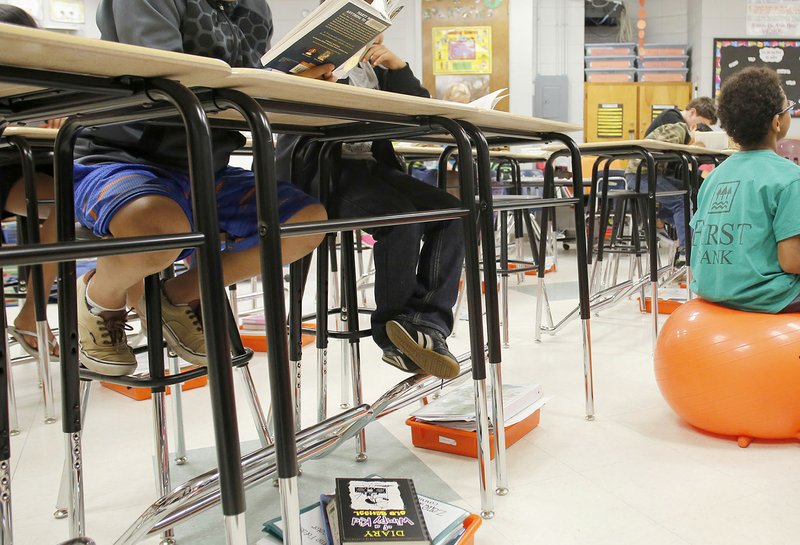Arkansas has spent about 95% of the $118.8 million it received last year in the first round of federal covid-19 relief money for schools and almost 60% of the $497.2 million it received in the second round of emergency funding.
The third, most recent round of special federal funding was the largest, and it is largely unspent.
Arkansas is receiving $1.12 billion in American Rescue Plan/Elementary and Secondary Education Emergency Relief -- or ESSER -- money and to date has spent less than 5% of it. A total of $1.07 billion is not yet expended.
All of that information about the special funding -- current as of Oct. 22, updated monthly and broken down by school district and program -- is available to the public on a user-friendly online dashboard.
The new Elementary & Secondary Education Transparency Dashboard has been created by the Arkansas Division of Elementary and Secondary Education.
"The dashboard shows spending under all three rounds of [Elementary and Secondary School Emergency Relief] funding through the CARES Act in May 2020, the Coronavirus Response and Relief Supplemental Appropriations Act in January 2021, and the American Rescue Plan in March 2021," the introduction to the new Arkansas dashboard states.
"The ESSER funding dashboard provides the public an opportunity to access information about how much of the funds have been used so far to improve student learning, address lost learning opportunities, support students' mental health and well-being, and more," the introduction continued.
Ivy Pfeffer, Arkansas' deputy education commissioner, demonstrated the transparency dashboard last week to the state Board of Education.
"We're excited to have this level of transparency to help answer questions and probably help drive some questions," Pfeffer told the board.
The dashboard site is: https://esser-insight.ade.arkansas.gov/.
It was created by Arijit Sarkar, who is the chief information officer and director of information systems for the state education agency.
The online dashboard shows the percentages and dollar amounts that have been expended by the school systems, Pfeffer said. The process calls for the state to use the federal money to reimburse the districts for their covid-19-related expenses.
About 27% of the money in all three rounds of funding has been spent and the districts have been reimbursed, according to the dashboard.
A lot of money is left, Pfeffer said, but also noted that the dashboard doesn't show the money that has been obligated by the districts but not yet actually spent. Those obligations could include pending construction projects, or technology and instructional materials that have been ordered but are yet to arrive in the districts, she said.
The dashboard shows the amount of money available to each of the state's traditional and charter school systems from each of the three rounds of funding, and how much has been spent from each of the rounds of funding.
Further, the dashboard shows how much districts have spent in broad categories of allowable expenses, such as technology, student supports, facilities, food security and systemic procedures.
The Alma School District, for example, has spent $1.28 million from the first round of funding and $100,259 from the second round of funding for a total of almost $1.39 million on technology purchases.
The Beebe School District, as another example, has drawn more than $1.9 million in all from the three rounds of funding for systemic procedures, which can include costs for transportation and other system needs to operate schools.
Each of the three rounds of funding must be spent within a certain time frame. The third and largest round of funding, for example, must be obligated by districts for spending by September 2024.
LR DISTRICT SPENDING
The Little Rock School District, the state's second largest school system in terms of enrollment, is scheduled to receive the largest amount of the special federal aid, $99.79 million in all -- of which $30.76 million has been spent, according to the state dashboard.
The capital city district has spent all but $28,547 of the almost $6.9 million it received in the first round of funding, and $23 million of the $28.6 million of the second round of funding.
The district has $63.65 million left of the $64.3 million it is allocated in from the third round.
School districts are obligated to spend at least 20% of their third-round American Rescue Plan money to address learning loss by students.
Members of the Little Rock School Board received a report last week that further breaks down that district's spending.
Deputy Superintendent Keith McGee showed different categories of expenditures, including costs for about 102 employees, most of whom work in the district's Ignite Digital Academy, a virtual kindergarten-through-12th grade program. Also included among the federally funded employees are some assistant principals in the district and instructional facilitators.
[LINK: See the uses of federal covid-19 relief funds » arkansasonline.com/1114covidfunds/]
The district has also used the federal money for personal protection equipment, computers and laptops, the Schoology digital learning platform, air filtration systems, student meals, science materials, a math curriculum, summer learning programs, and a one-time payment to employees for their extra work during the covid-19 pandemic..
The report prompted School Board member Ali Noland to repeat her earlier request that the School Board meet to decide how the remaining funds will be used. Noland said she wanted to be able to respond to constituents who will ask what the district has done with the federal money.
Ouida Newton of Leola, chairman of the Arkansas Board of Education, welcomed the new state dashboard as a needed source of information for the public.
"With the amount of money that districts got, it was almost mind-boggling," Newton said. "The transparency is so important. I appreciate what all the your team has done to make sure the public has the information," she told Pfeffer.
